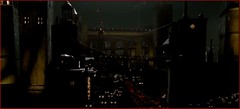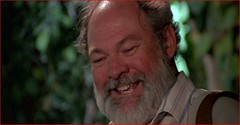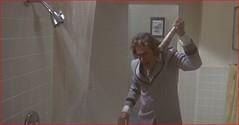.jpg)
I opened the door to my wheelhouse recently and found Piper there. Yes, he was talking chase scenes -- and left out Bullitt! Still trying to recover from my post-INLAND EMPIRE haze (another time, another post), I was not up to the challenge of entering the ring, but thankfully Moviezzz stepped into the opposite corner and threw the first punch, which Piper quickly countered. Though I'm late to the fight, a recent viewing of the Steve McQueen chase in question re-energized me, so here I am to defend Bullitt.
I've actually found myself in this position frequently -- usually after recommending Bullitt to someone who claims to be a car and/or chase scene buff. They inevitably come back disappointed, and I predictably sever all ties to them. Admittedly, my love for the Bullitt scene comes from at least a couple biases: I am a car guy -- my first real conversation with my wife was a one-sided education on the merits of the lesser Porsche models (the 944, 928, 968 etc.) and an explanation on how Porsche-philes identify 911s by series. Also, the chase in question features my favorite American car of all time -- the 1968 Dodge Charger R/T, which for my money is the most beautiful car ever manufactured in this country.
The '68 Charger is what helps Bullitt rise above other chases: the car looks evil, and is such driven by villains. If the Bug-Eyed Sprite looks like, well, a bug-eyed sprite, then the '68 Charger looks like Darth Vader. The sinister black Charger against Steve McQueen's American-as-apple-pie green Ford Mustang is a constant visual reminder of which chaser is good and evil. Looking at the combatants from a contemporary eye makes them more impressive -- these were two brutish cars (especially the Charger), built more for speed than corners. The '68 Charger sported a 440 "magnum" V8, which until the Viper debuted was the largest engine Chrysler would ever put in a car, and was a long and heavy coupe with no promises of tight cornering. McQueen's pony car had "only" the 390 V8, which would be eclipsed by the powerhouse 429 V8 in later models, but it was far lighter and more compact than the Charger. With this in mind, it's somewhat amazing seeing the two cars barrel through San Francisco hills -- sometimes unsuccessfully. The driving is sloppy at times because they were stock cars driven to the absolute limit.
What we have through the whole chase is a raw realism that ups the adrenaline considerably. In no other chase do you grit your teeth or squeeze your chair when the cars barely miss oncoming traffic and continually come close to bottoming out or flipping over. Because the chase was not in the original script, much of it was probably improvised and done in one shot: see the Charger's collision with a parked car after a failed turn, it's possible that it got hung up on this car because the Academy Award-winning editing (!!!) essentially makes most of the Charger vanish after the hit. The numerous continuity errors make the chase less a part of the movie, and more of a "look what we did" home recording: after witnessing the downhill leaps (by the Volkswagen Beetle) from the drivers' perspective, they go back up the hill and then we're treated to the same downhill sequence again, but from a different angle (keep an eye on the Beetle). If we're supposed to believe these were two unique sequences, then the Charger loses a total of five hubcaps before the chase is over.
So yes, it's raw, but it's also stylish. The chase begins slowly with a brilliant cat-and-mouse game set to breezy jazz, with McQueen hoodwinking his pursuers by slyly becoming the hunter. Just when you might be lulled to sleep, the Charger burns off and the jazz stops completely. With no dialog, the cars supply the score for the duration: rhythmic thump-thumps of their suspensions crashing after catching air, dueling engine notes between the roaring Ford and bass-heavy Dodge and the trumpeting tire shrieks on grip-testing turns. While the chase began softly and safely, it ends abruptly and brashly: the villains play dirty by bringing out a shotgun, but McQueen breaks out an ancient race car driver move and forces his rival into the non-existent barrier -- leading to a brutal fiery grave.
Subsequent movie chases would feature hidden ramps for maximum air, reinforced suspensions and replica cars. McQueen drove the Mustang himself, the two cars are driven recklessly for ass-off-your-seat asphalt air and the beautiful Charger in particular is beaten senselessly more out of apparent accident than aesthetics. Bullitt ushered in the modern chase scene, but there's still never been another one like it.
Monday, April 30, 2007
Bullitt Time
Filed Under Classic reviews
Subscribe to:
Post Comments (Atom)












4 comments:
Yes,
That's what I'm talking about. Love it.
I'm not a big car guy, but how can you not love The Charger.
I'm getting pretty bloody over this whole Bullitt thing but I don't care. It's got people writing and I love it.
I have a friend who e-mails me any time a McQueen movie is on and he will take great delight in the fact that I have created such a stir by dissing the Bullitt chase scene.
Just watched this scene again last night. Brilliant.
Still, I gotta award the title of "greatest car case" to The French Connection.
Thank you for the article, very worthwhile material.
here | here | here
Post a Comment